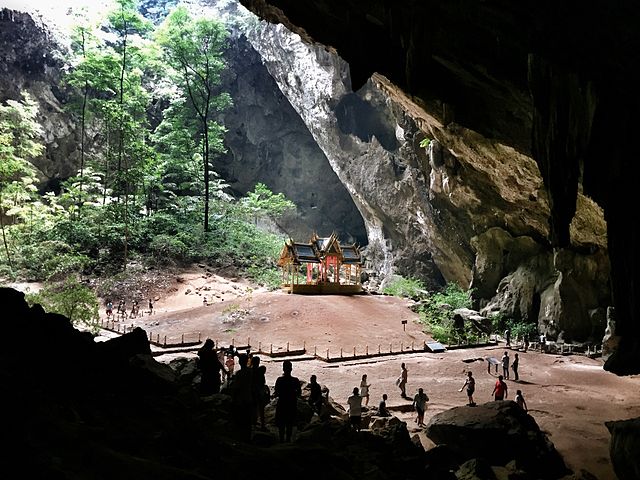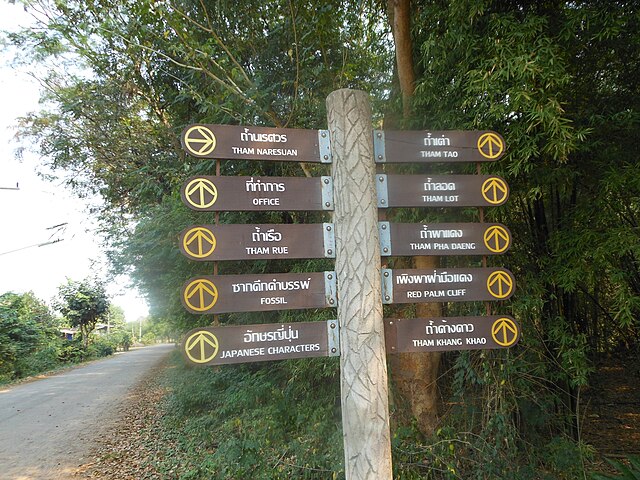
The Thammasat University Libraries have acquired a new book explaining the economic and touristic importance of caves. It was generously donated by Ajarn Adul Wichiencharoen and is shelved in the Adul Wichiencharoen Room of the Pridi Banomyong Library. Troglodytes of Saumur describes a famed tourist destination in France. Saumur is a town in western France, surrounded by the vineyards. The word troglodyte refers to people who live in caves. Its origins are from two Greek words meaning to dive into a cave. The author of Troglodytes of Saumur, Jacek Rewerski, is Polish-born geographer and historian now living in France. He explores how in the region of Saumur and the Loire Valley, people have hollowed out limestone caves and lived in them for centuries. They still do, to some extent, claiming that their caves retain warmth even during harsh winters, and are shielded from the sun so they remain cool during the summer. Some French people and foreigners buy caves as vacation homes, and enjoy the relative quiet, using these homes to store wine and grow mushrooms. In some troglodyte villages in France, underground Catholic chapels are included for praying. There are even troglodyte restaurants in France, including one serving Chinese food. Naturally tourists are amused to see these buildings, and some stay in underground rooms at troglodyte hotels.
Thailand and caves
Ajarn Adul must have been intrigued by the similarities and differences between caves in France and Thailand. As all Thais, the Kingdom has many caves made not by nature, not hollowed out by human workers. Many are notable tourist attractions for their natural beauty. They are also rich sources of animal life. In March, The Nation newspaper reported that an unusually large number of cream-colored butterflies were seen in Phitsanulok, drawing tourists to the area. The butterflies usually lived in caves at a lime hill. An even rarer natural discovery was made in caves in Thailand last year, The Bangkok Post noted. A species of fish with feet was found, climbing waterfalls in caves. Somewhere between common fish and land animals, these unusual creatures move somewhat like salamanders. According to the theory of evolution, fish eventually developed into land creatures, so this rare Thai animal gives us an idea of what that stage of evolution may have been like. In the scientific report published on the website of Nature Magazine, the blind cavefish Cryptotora thamicola is described, noting that although fish use different techniques to move out of water, none have ever been described as walk on landing like a four-legged animal. This study of Cryptotora thamicola was the first-ever description of behavioral adaptation in a living fish species as it approaches walking like a four-legged animal:
The blind cavefish Cryptotora thamicola… can walk up rocks in fast-flowing water and on wet surfaces in air.
These fish are found in Tham Mae Lana, a karst cave located in Mae Lana, Pang Mapha District, Mae Hong Son Province, Thailand. Karst is a landscape formed after rocks such as limestone, dolomite, and gypsum dissolve. Tham Mae Lana has many stalactites and an underground subterranean stream where the cavefish live, including the waterfall climbing one. Tham Mae Lana is not easy to explore, and tourists require local guides to get through it.

Cryptotora thamicola is also found at Tham Susa, located between between Mae Nam Lang and Mae Nam Pai. Like Tham Mae Lana, it is not an easy place to visit, due to high levels of carbon dioxide along its underground river. More enjoyable and fun for travelers are the Chiang Dao Caves in Northern Thailand. These caves run for 12 kilometers under Doi Chiang Dao (ดอยเชียงดาว) also called Doi Luang Chiang Dao (ดอยหลวงเชียงดาว), a 2,175 meter high mountain in Chiang Dao District of Chiang Mai Province, Thailand. It is one of the highest points of the Daen Lao Range on the Thai side of the border with Myanmar. Doi Chiang Dao is made of limestone, part of Chiang Dao Wildlife Sanctuary, south of Pha Daeng National Park. Doi Chiang Dao is one of the most popular birdwatching locations in Thailand with over 300 species of birds, including rare ones. There is folklore in the region claiming that Chiang Dao Caves, around two hours away by car from Chiang Mai, have many secret treasures that have not yet been seen, including a gold Buddha statue, textiles, and a sacred elephant, among other. Visitors can see lots of crystal formations formed by water dripping. Tourists are asked to pay an admission fee of 40 baht to help cover the cost of lighting in the front of the caves. Brave travelers who wish to experience the much larger dark portions of the caves must pay 100 baht fee to rent a gas lantern and 100 baht for a guide. This tour includes other caves as well, and requires some crawling though tight spaces, for those eager to try this type of challenge. Keep in mind the temperatures in caves can have a wide range from quite cool to very hot, and strong shoes are recommended. Some visitors also find it a good idea to bring their own flashlights, to brighten up the area in addition to the guide’s lantern.
Many other caves in Thailand attract visitors, including Khao Bin Cave, 20 kilometers away from Ratchaburi town along the route to Chom Bueng; Tham Chomphon Cave, 30 kilometers west of Ratchaburi city, near Chom Bueng; Hat Sai Kaeo Cave, located in Khlong Hat in Sa Kaeo province, part of the same mountain range as Tham Phet Pho Thong. Kao Kob Cave, located in Kao Kob Mountain, is surrounded by rubber trees and rice fields. Tham Muet is located at Khong Chiam in Ubon Ratchathani province. Wat Khao Wongkhot includes a bat cave, considered the largest in Lop Buri. Phraya Nakhon Cave is in Kui Buri District, managed by Khao Sam Roi Yot National Park. Khao Sam Roi Yot in Prachuap Khiri Khan Province is the leading marine national park of Thailand. Khao Sam Roi Yot means the mountain with three hundred peaks, describing limestone hills along the Gulf of Thailand. The northwest corner of the mountain range is Thung Sam Roi Yot, freshwater marsh covering over one third of the national park, as largest remaining wetlands area in Thailand. Phraya Nakhon is a large cave with a hole in its roof, through which sunlight enters. Here is a description of Tham Nam Lod from the website of Cave Lodge, a company organizing tours of the local attractions:
Guides (with lanterns) for Tham Lod are only 150 Baht per group (1-3 people), and the bamboo rafts inside the cave are 400 Baht for 3 people (return trip through the cave). It takes about 1.5 hours to see all three higher level caverns, and the main river tunnel. You can watch 300,000 birds fly into the cave every evening after sunset, in the twilight, for free. Tham Lod is an enormous river tunnel with 3 higher dry caverns. The cave walls are covered with massive formations and columns over 20 metres high tower over visitors. The third cavern shelters the remains of prehistoric teak coffins. Near the visitor centre is a recently excavated archaeological site- a rock shelter where a 20,000 year old human skeleton was found- the oldest in Nth Thailand. Info on the site is in Thai and English. Sometimes wild gibbons inhabit the forest near the cave entrance- follow the whoops and you may see them.A note on ecotourism: there are a few places in Thailand where “ecotourism” is a working reality. Tham Lod is one of these places. The local ethnic Shan community provides all of the guides and bamboo raft services for the cave, and receive all of the money. Tourism has helped reduce their reliance on slash & burn agriculture. The locals respect the cave, its ecosystem (the birds, bats, fish, and cave adapted snakes (harmless) are strictly protected.) When you visit Tham Lod, your money directly helps the local community.
(All images courtesy of Wikimedia Commons)

